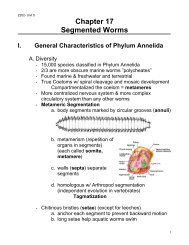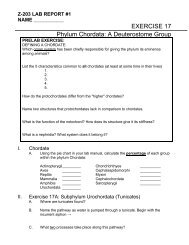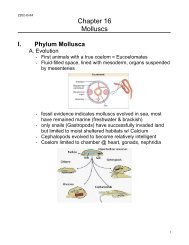Ch 23: Phylum Chordata - PorterMax
Ch 23: Phylum Chordata - PorterMax
Ch 23: Phylum Chordata - PorterMax
Create successful ePaper yourself
Turn your PDF publications into a flip-book with our unique Google optimized e-Paper software.
Z203/ Unit 1<br />
<strong>Ch</strong> <strong>23</strong>: <strong>Phylum</strong> <strong>Ch</strong>ordata<br />
I. <strong>Ch</strong>aracteristics<br />
Approximately 45,000 species in 8 major classes<br />
A. Structural Plan<br />
Shared features w/ Invertebrate Phyla:<br />
bilateral symmetry, anterioposterior axis, eucoelom,<br />
metamerism, cephalization, complete digestion<br />
Echinoderm/Hemichordate assemblage may be sister<br />
Groups that share:<br />
Deuterostomes =<br />
mouth 2 o derived<br />
coelom formed from<br />
pouches in<br />
mesoderm<br />
name CHORDATA comes from Notochord<br />
(rodlike, semi rigid tissue enclosed in connective tissue)<br />
Notochord extends length of body & lies between gut<br />
tube & nervous system<br />
serves to stiffen body or act as<br />
skeletal axis<br />
<strong>Ch</strong>ordates have more structural<br />
unity than other phyla, share 5<br />
hallmark characteristics plus<br />
genetics<br />
1
II. Five <strong>Ch</strong>ordate Hallmarks<br />
A. Notochord<br />
always found at some embryonic stage of all chordates<br />
1 st part of endoskeleton to develop<br />
serves as axis for muscle attachment<br />
may persist throughout<br />
life (protochordates &<br />
jawless vertebrates) or<br />
be lost completely w/<br />
metamorphosis<br />
series of cartilaginous bony vertebrae form in<br />
vertebrates derived from mesoderm cells lateral<br />
to notochord<br />
most vertebrates, notochord displaced by vertebrae<br />
(remains persist as intervertebral discs)<br />
B. Hollow Dorsal Nerve Cord (Tubular)<br />
single cord dorsal to alimentary canal<br />
(ventral in invertebrates)<br />
anterior end enlarges to form brain<br />
cord produced by infolding of ectoderm on dorsal side<br />
C. Pharyngeal Pouches & Slits<br />
slits lead from pharyngeal cavity to outside<br />
form by inpocketing of ectoderm &<br />
outpocketing of pharynx endoderm<br />
2 pockets join in aquatic chordates & form<br />
complete slit for filter feeding & respiration<br />
2
grooves persist (pockets don’t join) in amniote chordates<br />
(give rise to structures: eustachian tubes, middle ear cavity,<br />
tonsils, & parathyroid glands)<br />
D. Endostyle<br />
mucous secreting structure found in the Pharynx floor<br />
(traps small food particles)<br />
found in Protochordates & Lamprey larvae<br />
cells associated secrete iodinebased proteins (Thyroid<br />
gland in Vertebrates)<br />
E. Postanal Tail<br />
works with muscles (Myomeres) & notochord to provide<br />
motility & stability<br />
Aids in propulsion in nonvertebrates & fish but vestigial in later<br />
lineages<br />
III. Ancestry & Evolution<br />
A. History<br />
earliest protochordates soft bodied (not fossilized)<br />
deuterostomes are natural grouping w/ common origin<br />
in Precambrian Seas<br />
(Echinoderms, Hemichordates, <strong>Ch</strong>ordates)<br />
anatomical, developmental, & molecular evidence<br />
indicates chordates arose 570mya from lineage<br />
related to Echinoderms & Hemichordates<br />
significant developments occurred within chordates:<br />
skull, jaw, amnion, fins & limb arrangement<br />
3
group divided into 3 Subphylum<br />
1. Urochordata<br />
2. Cephalochordata<br />
3. <strong>Ch</strong>ordata<br />
INVERTEBRATE CHORDATES:<br />
IV. Subphylum Urochordata<br />
"Tunicates"<br />
“Tail <strong>Ch</strong>ordates”<br />
A. General <strong>Ch</strong>aracteristics<br />
2,000 species; occur in all seas & at all depths<br />
free living larva, most adults metamorphose into sessile<br />
only larvae bears all chordate hallmarks; most adults<br />
only retain a few<br />
EXTERNAL:<br />
tunic (tough nonliving test produced by mantle)<br />
surrounds body that contains Cellulose<br />
adults form has saclike body with stolons at the base and<br />
siphons at the top (may have more than 2 & colonial forms<br />
merge their siphons:<br />
Incurrent siphon has sensory tentacles<br />
Excurrent siphon has pigment<br />
spots<br />
INTERNAL:<br />
flow pattern of water functions in<br />
respiration & digestion & excretion<br />
(incurrent siphon→pharynx→gill<br />
slits→aterial cavity<br />
→excurrent siphon)<br />
Respiration occurs across pharyngeal gill slits<br />
Digestion – extracellular complete using mucous nets secreted<br />
by endostyle to capture food particles<br />
(incurrent siphon→pharynx→gill slits→esophagus<br />
→stomach→intestine→anus→atrial cavity→<br />
excurrent siphon)<br />
4
Open circulatory system with ventral heart + 2 large blood<br />
vessels (pumps 2 directions)<br />
* unique blood characteristics (RBC without hemoglobin)<br />
* blood flow through gill slits aids in respiration & excretion<br />
Nervous system – reduction of dorsal nerve cord & ganglia in<br />
adult (sessile way of life)<br />
notochord & tail disappear in metamorphosis<br />
Reproduction – dioecious with larva free<br />
swimming (larva retain chordate features)<br />
3 Groups:<br />
Ascidians "sea squirts"<br />
Thalacians "salps"<br />
Larvacea "larval tunicates"<br />
(paedomorphic)<br />
V. Subphylum Cephalochordata "Lancelets"<br />
“Head <strong>Ch</strong>ordates”<br />
A. General <strong>Ch</strong>aracteristics<br />
29 species worldwide, 5 species in North American<br />
live in sandy bottom of coastal waters<br />
EXTERNAL:<br />
slender, laterally flattened, translucent, 57cm<br />
reduced fins each with a finray aid in movement & digging<br />
(dorsal, caudal, ventral)<br />
fusiform body shape (tapered anterior & posterior)<br />
*Amphioxus = “both ends” “sharp”<br />
anterior end has rostrum, oral hood,<br />
oral tentacles @ mouth<br />
INTERNAL:<br />
retain the 5 distinct chordate<br />
characters in simple form<br />
5
Respiration – flow pattern of water across gill slits<br />
Digestion – Complete system with cilia (wheel organ) driving<br />
currents for filter feeding (like tunicates)<br />
*Endostyle located at floor of Pharynx<br />
*Cecum resembles vertebrate pancreas (secretes enz)<br />
(tentacles→wheel organ→mouth→pharynx→gill slits<br />
(endostyle)→stomach (hepatic cecum)→intestine→anus)<br />
Trunk muscles suggest vertebrate pattern (myomeres)<br />
Circulatory same basic Closed circulatory plan as vertebrates<br />
*no heart – modified arteries for pumping<br />
*capillaries in gill slits increase gas exchange for respiration<br />
* blood only carry nutrients no RBC or Hg for O 2<br />
Excretory several Ushaped Nephridia (exit atriopore)<br />
Nervous system consists of ganglia + dorsal nerve cord &<br />
spinal nerves<br />
* simple senses include tactile & chemoreceptors<br />
* ocelli (eye spots) for light detection<br />
Reproduction – Dioecious with gonads ventral to pharynx<br />
* gametes exit atriopore<br />
VI. Subphylum Vertebrata<br />
“Craniata”<br />
A. General <strong>Ch</strong>aracteristics<br />
EXTERNAL:<br />
1. Cephalization<br />
predominance of head and its development drive distinct<br />
bilateral symmetry & nervous system advancements<br />
6
2. Paired Limbs<br />
pectoral & pelvic appendages originate as swimming<br />
stabilizers<br />
jointed limbs suited for terrestrial life & permit fine movement<br />
INTERNAL:<br />
1. Living Endoskeleton<br />
internal location departs from invertebrate pattern<br />
grows w/ body, not confining nor molted<br />
greater economy of building materials<br />
provides jointed scaffolding for muscles; muscles<br />
cushion it from impact<br />
skull & ribcage enclose & protect vital organs<br />
bony plates , tough integument protects (exoskeleton)<br />
cartilage likely 1 st endoskeletal material<br />
*superior to bone for fast growth)<br />
cartilage remains 1 o endoskeletal material for<br />
Agnathans & sharks<br />
bones offer advantage of storing minerals (P,Ca) &<br />
mechanical strength for terrestrial life<br />
2. Physiology – system become more complex<br />
Respiration – perforated pharynx originated for filter feeding<br />
* evolved to a muscular pharynx for pumping water<br />
* shifted function from feeding to respiratory (gills or lungs)<br />
Digestion – Complete system with more specialization<br />
* accessory digestive glands (liver & pancreas) needed<br />
for larger food processing<br />
7
Circulatory – Closed system w/ multiple chambered hearts and<br />
blood components<br />
* RBC with hemoglobin aid in<br />
O 2 dispersal<br />
* Aortic arches dedicated to<br />
gill slits for gas<br />
exchange<br />
Excretory paired kidneys<br />
remove metabolic waste<br />
products<br />
3. Advanced Nervous System<br />
switch to active predation favored sensory, motor &<br />
integrative controls<br />
anterior end of nerve cord became tripartite brain<br />
(forebrain, midbrain, hindbrain)<br />
selected for sensory organs:<br />
* paired eyes w/ lenses &<br />
inverted retinas,<br />
* paired ears,<br />
* receptors (pressure, electro &<br />
chemo)<br />
head & paired sense organs<br />
possible due to derivatives of<br />
ectoderm germ layers:<br />
*neural crest (ectodermal cells) develops into<br />
structures (cranium, teeth, ganglia, endocrine<br />
glands, & some nerves)<br />
*epidermal placoides (plate like ectodermal<br />
thickenings) give rise to olfactory r/c, eye lens, inner<br />
ear epithelium, & receptors (taste, photo & lateral<br />
line mechano)<br />
8
significant changes in genetics (duplication of Hox genes)<br />
drove changes in nervous system and entire body<br />
*1 copy of Hox genes in Amphioxus<br />
* 4 copies in Gnathostomes<br />
VII. Evolutionary History<br />
A. Ancestral Invertebrate <strong>Ch</strong>ordates<br />
ribbonshaped fish from MidCambrian are oldest<br />
invertebrate <strong>Ch</strong>ordate fossils seen<br />
(similar to lancelets)<br />
Garstang's Hypothesis of <strong>Ch</strong>ordate Larval Evolution (1928)<br />
Paedomorphosis: larvae failed to metamorphosis into adult<br />
form, but developed gonads & reproduced in larval stage<br />
Lancelets diverged early from shared common ancestor<br />
w/ tunicates & many consider them sister group & closest<br />
living relative to vertebrates<br />
Lamprey larva (ammocoetes) were once believed to be<br />
adult lancelets due to similarities<br />
9
B. Earliest Vertebrates<br />
1. Superclass Agnatha: Jawless Ostracoderms<br />
articulated fossils found from late Cambrian (530mya)<br />
heavily armored (bones in dermis) extinct fish<br />
(lasted 150mya)<br />
lacked lateral fins for stabilization<br />
rudimentary vertebrae<br />
fixed circular mouth<br />
2. Superclass Agnatha: Modern Jawless Fish<br />
naked hagfish and lampreys<br />
classification based on missing trait paraphyletic<br />
3. Gnathostomes: Early Jawed Vertebrates<br />
all have jaws = modifications of 1 st two cartilaginous<br />
gill arches derived from neural crest (not<br />
mesoderm like most bones)<br />
jaw musculature homologous to gill musculature<br />
most likely monophyletic group<br />
Placoderms (early Devonian)<br />
among 1 st jawed vertebrates<br />
armored fish covered w/ diamond shaped scales<br />
or large plates<br />
great diversity arose but went extinct by<br />
Devonian period<br />
grew to 10m length<br />
Acanthodians<br />
gave rise to modern bony fish<br />
4. Modern Fish & Tetrapods<br />
ancestry uncertain<br />
unknown from which chordate group vertebrate<br />
lineage originated<br />
10
C. Classification of <strong>Phylum</strong> <strong>Ch</strong>ordata<br />
Protochordata (Acrania)<br />
Subphylum Urochordata (tunicates)<br />
Subphylum Cephalochordata (lancelets)<br />
Craniata<br />
Subphylum Vertebrata<br />
Superclass Agnatha<br />
Class Myxini (hagfish)<br />
Class Pteromyzontida (lamprey)<br />
Superclass Gnathostomata<br />
Class <strong>Ch</strong>ondrichthyes<br />
Class Actinopterygii<br />
Class Sarcopterygii<br />
Class Amphibia<br />
Class Reptilia<br />
Class Aves<br />
Class Mammalia<br />
(sharks, rays, skates)<br />
(rayfinned fish)<br />
(lobefinned fish)<br />
11





